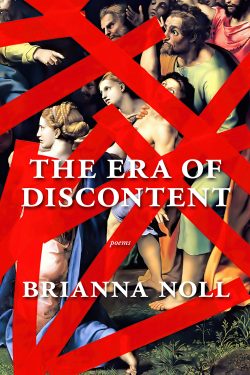“This is the era of building/ and taking apart, our landscapes/ and skylines changing, shaken/ as the tectonics of the moon…/ This isn’t hyperbole–/ we’re terrified of entropy, of the world/ as it once was. This is the era of discontent/ where imagination’s gone mad” – Brianna Noll, “Aesthetics for Toxic Times”
Brianna Noll’s second collection of poems, The Era of Discontent, is laden with both the frustrated and hopeful ruminations of a society in crisis. Written and published during the Covid-19 pandemic, the collection is a rallying cry for those disillusioned by the promises of modernity — and a call to remember humanity’s roots as we rebuild.
Noll’s work is enigmatic– deliciously rich in its intricacies, it requires careful contemplation from the reader. She masterfully weaves a vast array of muses into the collection’s fabric, blowing the dust off of forgotten artifacts, individuals, and legends. Noll’s prose emboldens us with a sense of urgency and wonder as we scour the internet for additional context. In “How to Give Birth to a Rabbit (after Mary Toft, 1726)”, Noll approaches the universal, heart-wrenching grief of a miscarriage via the story of Mary Toft, who infamously convinced several 18th-century doctors she’d given birth to a rabbit following the loss of her pregnancy. It was later revealed to be a hoax, and Toft became the subject of much scrutiny.
“This makes you a monster,/ of course” Noll writes. “Tread lightly./ No one will think about/ your miscarriages, your/ empty salt cellars and/ candles re-formed from/ their drippings, which alone/ mean little but add up to/ a fervent kind of desperation.”
It’s in her compassionate treatment of stories like Toft’s that Noll shines. She mixes current events and cultural oddities to evince ideals that transcend space, time, history, and belief—placing her squarely in conversation with something more overtly cosmic.
Still, these detours don’t detract from the collection’s purposeful and timely narrative arc. The collection is broken into three untitled sections artfully structured by Noll to play off of each other. In the opening pages, Noll cheekily offers her readers insight into her central line of inquiry. “Epistemological Snapshot” finds Noll rebelling against the assumed, unquestioned truths of our existence — comparing them to a ruler in both measurement and rigidity. Noll implores her readers not to become complacent and to remain curious, writing, “You know you cannot know what actually exists–/ you’re just tired of the same old stories.”
After setting up her epistemology, Noll peppers the first section with sharp criticism and warnings. In “Isolationism,” we find a rare moment where Noll uses the first-person to reflect. She laments, “But I worry we’ve otherwise become/ strangers in our own worlds, / and isolated in turn. What do we hold/ on to when the world around us/ fades at twilight? There’s little and less/ to grasp when our eyes, so used/ to light, must acclimate to the dark.”
Positioned against the woes of the first section, Noll’s voice in the second is luminous, baptismal water. It offers solace, companionship, and encouragement. In “The Lake We Call Medusa,” Noll pleads:
“You must be/ a light-bearer,/ or the water will/ make a statue/ of you, calcify you/ from the outside in… You are/ your own instrument./ You must learn/ to cast light/ from your fingertips,/ your vocal chords,/ or better yet, your/ pores. The demon/ in this water cannot/ bear the dawn.”
The final section crescendos with a deep ache to reconnect with our humanity, exemplified in “The Collective Unconscious”:
“Some things have been with us/ a long time, like the words spit, / fire, and mother, or the color/ black. We are born with them/ on our tongues, as we are born/ knowing that haloed suns foretell/ rain. We share the land and / the language to speak it, but/ these commons grow fewer, / and we’ve stopped trusting/ in lore… Look backward:/ anyone who’s seen a lingonberry has named it for an animal: cowberry, foxberry, bearberry, cougarberry. / This is the legacy we leave—truths we feel in each other’s bones.”
The Era of Discontent provides readers with a welcomed respite from the loneliness, chaos, and confusion of our current cultural epoch: a gaze into our ancestral precedence, creating a concrete antithesis to the digital-age’s intangibility. In “Elegy for the Ground We Walk On,” Noll ends with a message of hope as she considers the changes necessary for a brighter future, writing, “This need not be a disaster:/ we could better cultivate our sight, / unclench our hands, and learn new/ words for a world we do not shape/ to our will, but shapes itself–/ more pliant than we’ve ever believed.”
The Era of Discontent is available from Elixir Press for $17.00.

